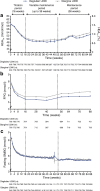Risk of hypoglycaemia with insulin degludec versus insulin glargine U300 in insulin-treated patients with type 2 diabetes: the randomised, head-to-head CONCLUDE trial
- PMID: 31984443
- PMCID: PMC7054369
- DOI: 10.1007/s00125-019-05080-9
Risk of hypoglycaemia with insulin degludec versus insulin glargine U300 in insulin-treated patients with type 2 diabetes: the randomised, head-to-head CONCLUDE trial
Abstract
Aims/hypothesis: A head-to-head randomised trial was conducted to evaluate hypoglycaemia safety with insulin degludec 200 U/ml (degludec U200) and insulin glargine 300 U/ml (glargine U300) in individuals with type 2 diabetes treated with basal insulin.
Methods: This randomised (1:1), open-label, treat-to-target, multinational trial included individuals with type 2 diabetes, aged ≥18 years with HbA1c ≤80 mmol/mol (9.5%) and BMI ≤45 kg/m2. Participants were previously treated with basal insulin with or without oral glucose-lowering drugs (excluding insulin secretagogues) and had to fulfil at least one predefined criterion for hypoglycaemia risk. Both degludec U200 and glargine U300 were similarly titrated to a fasting blood glucose target of 4.0-5.0 mmol/l. Endpoints were assessed during a 36 week maintenance period and a total treatment period up to 88 weeks. There were three hypoglycaemia endpoints: (1) overall symptomatic hypoglycaemia (either severe, an event requiring third-party assistance, or confirmed by blood glucose [<3.1 mmol/l] with symptoms); (2) nocturnal symptomatic hypoglycaemia (severe or confirmed by blood glucose with symptoms, between 00:01 and 05:59 h); and (3) severe hypoglycaemia. The primary endpoint was the number of overall symptomatic hypoglycaemic events in the maintenance period. Secondary hypoglycaemia endpoints included the number of nocturnal symptomatic events and number of severe hypoglycaemic events during the maintenance period.
Results: Of the 1609 randomised participants, 733 of 805 (91.1%) in the degludec U200 arm and 734 of 804 (91.3%) in the glargine U300 arm completed the trial (87.3% and 87.8% completed on treatment, respectively). Baseline characteristics were comparable between the two treatment arms. For the primary endpoint, the rate of overall symptomatic hypoglycaemia was not significantly lower with degludec U200 vs glargine U300 (rate ratio [RR] 0.88 [95% CI 0.73, 1.06]). As there was no significant difference between treatments for the primary endpoint, the confirmatory testing procedure for superiority was stopped. The pre-specified confirmatory secondary hypoglycaemia endpoints were analysed using pre-specified statistical models but were now considered exploratory. These endpoints showed a lower rate of nocturnal symptomatic hypoglycaemia (RR 0.63 [95% CI 0.48, 0.84]) and severe hypoglycaemia (RR 0.20 [95% CI 0.07, 0.57]) with degludec U200 vs glargine U300.
Conclusions/interpretation: There was no significant difference in the rate of overall symptomatic hypoglycaemia with degludec U200 vs glargine U300 in the maintenance period. The rates of nocturnal symptomatic and severe hypoglycaemia were nominally significantly lower with degludec U200 during the maintenance period compared with glargine U300.
Trial registration: ClinicalTrials.gov NCT03078478 FUNDING: This trial was funded by Novo Nordisk (Bagsvaerd, Denmark).
Keywords: Clinical science; Hypoglycaemia; Insulin degludec; Insulin glargine; Insulin therapy.
Figures







Comment in
-
How conclusive is the CONCLUDE trial?Diabetologia. 2020 Apr;63(4):692-697. doi: 10.1007/s00125-020-05086-8. Epub 2020 Jan 16. Diabetologia. 2020. PMID: 31950229
Similar articles
-
(Ultra-)long-acting insulin analogues versus NPH insulin (human isophane insulin) for adults with type 2 diabetes mellitus.Cochrane Database Syst Rev. 2020 Nov 9;11(11):CD005613. doi: 10.1002/14651858.CD005613.pub4. Cochrane Database Syst Rev. 2020. PMID: 33166419 Free PMC article.
-
How conclusive is the CONCLUDE trial?Diabetologia. 2020 Apr;63(4):692-697. doi: 10.1007/s00125-020-05086-8. Epub 2020 Jan 16. Diabetologia. 2020. PMID: 31950229
-
Insulin degludec, an ultra-longacting basal insulin, versus insulin glargine in basal-bolus treatment with mealtime insulin aspart in type 2 diabetes (BEGIN Basal-Bolus Type 2): a phase 3, randomised, open-label, treat-to-target non-inferiority trial.Lancet. 2012 Apr 21;379(9825):1498-507. doi: 10.1016/S0140-6736(12)60205-0. Lancet. 2012. PMID: 22521072 Clinical Trial.
-
Effect of Insulin Degludec vs Insulin Glargine U100 on Hypoglycemia in Patients With Type 2 Diabetes: The SWITCH 2 Randomized Clinical Trial.JAMA. 2017 Jul 4;318(1):45-56. doi: 10.1001/jama.2017.7117. JAMA. 2017. PMID: 28672317 Free PMC article. Clinical Trial.
-
(Ultra-)long-acting insulin analogues for people with type 1 diabetes mellitus.Cochrane Database Syst Rev. 2021 Mar 4;3(3):CD013498. doi: 10.1002/14651858.CD013498.pub2. Cochrane Database Syst Rev. 2021. PMID: 33662147 Free PMC article.
Cited by
-
Efficacy and safety of insulin glargine 300 units/mL vs insulin degludec in patients with type 1 and type 2 diabetes: a systematic review and meta-analysis.Front Endocrinol (Lausanne). 2024 Jan 19;14:1285147. doi: 10.3389/fendo.2023.1285147. eCollection 2023. Front Endocrinol (Lausanne). 2024. PMID: 38313835 Free PMC article.
-
100 years on: the impact of the discovery of insulin on clinical outcomes.BMJ Open Diabetes Res Care. 2021 Aug;9(1):e002373. doi: 10.1136/bmjdrc-2021-002373. BMJ Open Diabetes Res Care. 2021. PMID: 34400466 Free PMC article. Review.
-
Impact of kidney function on the safety and efficacy of insulin degludec versus insulin glargine U300 in people with type 2 diabetes: A post hoc analysis of the CONCLUDE trial.Diabetes Obes Metab. 2022 Feb;24(2):332-336. doi: 10.1111/dom.14564. Epub 2021 Oct 17. Diabetes Obes Metab. 2022. PMID: 34605127 Free PMC article. No abstract available.
-
Recent Advances in Insulin Therapy.Diabetes Technol Ther. 2020 Dec;22(12):929-936. doi: 10.1089/dia.2020.0065. Epub 2020 May 12. Diabetes Technol Ther. 2020. PMID: 32310681 Free PMC article. Review.
-
Randomised Controlled Trials in Diabetes Research: A Pathway to Interpreting Published Results.Diabetes Ther. 2021 Oct;12(10):2635-2644. doi: 10.1007/s13300-021-01143-6. Epub 2021 Aug 29. Diabetes Ther. 2021. PMID: 34455574 Free PMC article. No abstract available.
References
-
- Leiter LA, Yale J-F, Chiasson J-L, Harris S, Kleinstiver P, Sauriol L. Assessment of the impact of fear of hypoglycemic episodes on glycemic and hypoglycemia management. Can J Diabetes. 2005;29(3):186–192.
-
- Becker RH, Dahmen R, Bergmann K, Lehmann A, Jax T, Heise T. New insulin glargine 300 units ml−1 provides a more even activity profile and prolonged glycemic control at steady state compared with insulin glargine 100 units ml−1. Diabetes Care. 2015;38(4):637–643. doi: 10.2337/dc14-0006. - DOI - PubMed
Publication types
MeSH terms
Substances
Associated data
Grants and funding
LinkOut - more resources
Full Text Sources
Medical
Research Materials
Miscellaneous

